Most people think that it was too difficult to transport whole blocks to build pyramids. So there must be a simpler solution. The simplest thinkable solution is to transport stones portionwise, as I did in my basic calculation of the build-section. Small portions, casted together to one block on the pyramid itself. Basis for all these cast-theories are examinations of travellers from the 17th to 19th century who were unable to explain those close joints and deformed blocks used for example at Menkaure's pyramid without using some "soft-stone-technique".
Experimental examination of ancient building methods advanced a lot in the last century, and today we need no formable stones to explain most of the 19th century riddles, and with chemical analysis it is now possible to trace each building block right back to its original quarry, as did the Geologists H.D. und R. Klemm during the last 20 years. The end for artificial stones?
The French chemist and pyramid explorer Joseph Davidovits has the opinion that the quarry- and transport problem for the building of the pyramids cannot be resolved with traditional methods. One reason he lists in his 1988 book The Pyramids - An Enigma solved is, that it should be impossibile to quarry and transport stones in the way archaeology proposes. Additionally, the ramp was a feat too big for these old folks.
Because of this hee looked for a solution to come around the ramp and the transport problem. And as expert in artificial stone (which is produced in his own company) he had an (at first glance) brilliant idea:
"This type of fossil-shell limestone concrete would have been cast or packed into molds. Egyptian workmen went to outcrops of relatively soft limestone, disaggregated it with water, then mixed the muddy limestone (including the fossil-shells) with lime and zeolite-forming materials such as kaolin clay, silt, and the Egyptian salt natron (sodium carbonate). The limestone mud was carried up by the bucketful and then poured, packed or rammed into molds (made of wood, stone, clay or brick) placed on the pyramid sides. This re-agglomerated limestone, bonded by geochemical reaction (called geopolymer cement), thus hardened into resistant blocks."
This is an excerp from the Homepage of his company Geopolymer, wherefrom I took several other of his claims.
The idea behind this: You need no expensive and complicated ramp, you can carry the baskets of wet pre-rock simply up the steps of the pyramid core. The only thing you need are some ladders.
ALL big pyramids were built with this method, according to Davodovits. The knowledge got lost durig the 5th dynasty (why???), and the descendants of the great builders, stuck with stone, were unable to follow up. This is the real reason for the decline in pyramid building, so Davidovits.
One of the major problems I had with Davidovits was that he can produce very little evidence to support his idea, his book (and his web site) lives from belitteleing the stupid scientists and their crazy ideas to show his ideas in a better light. His main points of evidence are the totally uniform pyramid core blocks, the precision with which they are put together so that not "a sheet of paper or a razor blade can be put between them", and the translation of a stela from the late periode which should contain a recipe for artificial stone, handed down from the earliest times of Egypt.
Several critics of Davidovits (this includes me :-) ) were arguing early that several passages of his book are only understandeable if the author never had visited the pyramids in person. Several of his claims can be disproven just by looking at the pyramids with the naked eye:
Following you will see some examples of blocks from pyramids of the 4th dynasty:
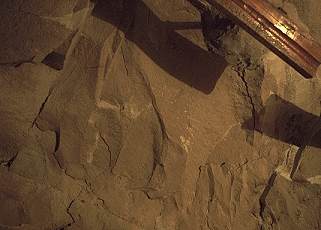
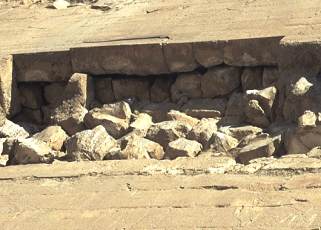
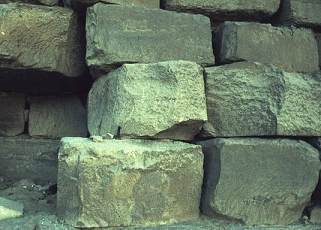
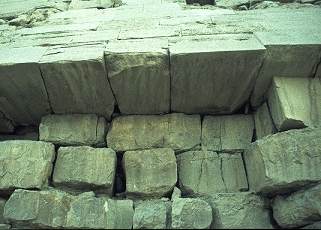
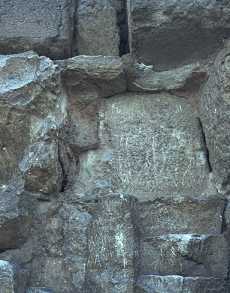
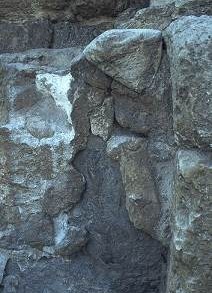
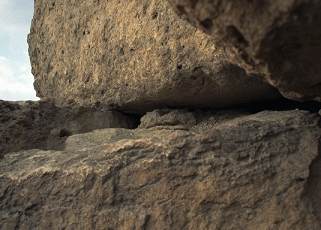
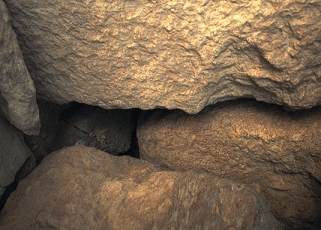
These pictures are contradicting Davidovit's main arguments: neither are the pyramid blocks uniform or regular, neither are they layed out with "1/10th millimeter precision". Not even his argument of a uniform layer thickness is correct, it is reached as we can see at Khufu's pyramid partly by risky stacking of smaller stones. Also there are several constructions which could not have been casted at all, like the constellation in Tab. (5)
The breach-pictures are especially interesting, because the stones there were protected from weathering. Like the stones behind the mantle in Meidum which are totally irregular, even the back side of the casing blocks are irregular. But there seems to be a planned gap between casing and core blocks (which was probably filled with sand), so that no casting could have had accured there. Interesting, too, is the irregular form and the ends of the casing blocks of the bent pyramid. This, together with the loosely stacked blocks of this pyramid, should be the end of any cast-debate. It is nearly impossible to cast such forms.
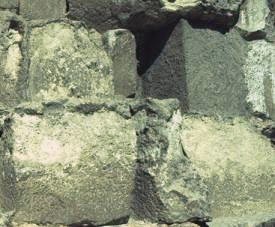 How could such irregular blocks have been formed? How casted blocks would look can be seen on the south side of the great pyramid. There Vyse blasted a gap into the face of the pyramid to look for a secret entrance. To stabilize this, concrete blocks were casted. It is very easy to see the difference between the natural and later casted blocks. The regular form of the newer block on the right is clearly visible and in contrast to the original blocks on the left (with ancient mortar between them)
How could such irregular blocks have been formed? How casted blocks would look can be seen on the south side of the great pyramid. There Vyse blasted a gap into the face of the pyramid to look for a secret entrance. To stabilize this, concrete blocks were casted. It is very easy to see the difference between the natural and later casted blocks. The regular form of the newer block on the right is clearly visible and in contrast to the original blocks on the left (with ancient mortar between them)
Another problem: If the Egyptians had used bottomless moulds, the material should have run between the gaps of the stones. A phenomenon nowhere to be seen on the pyramids, therefore the Egyptians must have had used casts with a bottom plate. But how and why were these removed? Davidovits argued, that the mortar visible between the stones were his casts - but this morter can nearly never be seen between different layers, most of the blocks are loosely stacked. So where are the moulds??? Another problem: the material of the mould (wood, brickwall, mortar/stone) forms prints on the surface of the casted objects. But where are they? All we can see are traces from breaking the stones - and from tools!!!
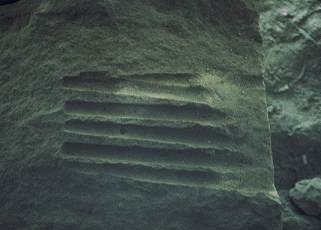
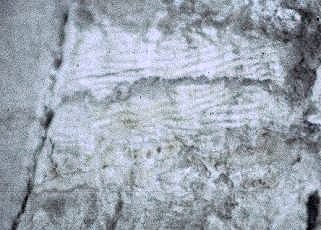
The picture on the right shows the typical trace of a split block. To do this, several small chisels were driven into a small area of the stone to get a crack. After this, you can chase the crack around with several chisels wider apart until the stone splits. This block is one in the ceiling of second nieche in the Meidum-pyramid, like the one on the rigth side. This block shows traces of chisels used to cut away obstacles on the surface. You can find these two traces anywhere on the pyramids if you keep your eyes open.
But why should anyone work the surfaces of casted blocks? Why should one split or dress such a block? Especcially when Davidovits claims that the Egyptians had no tools to work or dress stone. Again a fault in Davidivits' theory!
Preliminary conclusion: A look at the building blocks of the pyramid suggests that Davidovits never took a look at his victims, the pyramids. I have no other explanation for the difference between Davidovits' premise and the real situation on location. In my opinion his Idea is already dead here.
Erich von Däniken calculated several years ago that the Egyptians needed to transport one block of about 2500 kg weight every 2 minutes to the pyramid to be ready in 20 years. Such a block can be handeled by about 20 men without major problems (look at "Force, work and ramps" in the archaeology/building-section). If we use a typical distance of 1000 meters from quarry to the desired position of the block on the pyramid, and a transporting speed of 20 meters per minute, we need a constant flow of 25 transport groups with 20 men each to, and an equal number back from the pyramid. Only 1000 men are necessary to achieve this.
Davidovits on the other hand comes to very silly conclusions:
"2.The Transport of the Statue of Djehutihotep (1800 BC): 800 years after pyramid construction. Calculations deducted from this method yields that the transport of pyramid blocks on sledges would have required at least 52,500 men working together at one time. Yet, it would have been impossible to get the job done. This enormous number of men would have been squeezed together shoulder to shoulder at the work site, an area about the size of a large sports arena."
Hm, the picture of this transport gives him the estimated number of more than 50000 men? How? The statue weighs about 60 tons, and about 200 workers are shown transporting it. If we scale this down we find out, that according to this picture only 9 worker per 2.5 t-portion were needed, less than half of what I used, only 500 persons for the whole transport flow. So how does Davidovits come to such outrageous numbers?
In reality Davidovits' method makes the transport problem worse. In his theory the workers carried the wet proto-stone in baskets up the pyramid, so that about 50% of the dry weight had to be transported in form of water, too. In contrast to the force-saving sled pulling the baskets had to be carried. I think 50 kg is the upper limit a worker could carry constantly. The wet weight of a 2.5 t stone would have been between 3.5 and 4 tons, so each block needed at least 70 workers to carry the wet stone to the mould! Instead of 1000 persons you would have needed at least 3500.
The production of such a block makes some problems, too. In the infamous Nova-experiment Egyptologist Mark Lehner and Stone dresser Roger Hopkins visited the Mokkatam quarries, where stones are broken the same way as 5000 years ago. Th only difference are the iron tools used today. In this experiment, only 14 quarryworkers produced 200 blocks in only 12 days, using the traditional methods. One worker therefore produced the equivalent of 1.2 blocks per day. From Egyptan models and reliefs we know that the typical quarry team had 6 members, so each team could have prepared 2 blocks per day without any problem. In connection with a pull-team a block needed only 5 hours from to be an integral part of the rock formation to to be one of the largest manmade mountain.
The method to break stones: First a small ditch was hewn from the rock on 3 sides of the planned block. This ditch was so wide to put a foot into, and as deep as the planned stone should be high. The ditch behind the stone was the front of a new block. When it was completed, the small chisels we know from the Meidum pyramid were hewn from the front into the block, whereas people with levers were werking to assert force to the aft ditch. With these mehthods a crack was created along which the block splits from the ground. In the Nova-experiment normaly longer ditches were prepared to break loose a raw block for 2 or 3 stones. This raw block could be split very easily by perforating it along the planed boundary. After this a few hits with a heavy chisel and hammer are all thet is needed to separate such a block. Funny: Exactly such traces can be found on raw blocks in the valley temple of the bent pyramid...
Before I forget: prepared but not yet loosened blocks can be found in the quarry areas of Giza, like these in the southern Khafere-quarry I found in 1997:

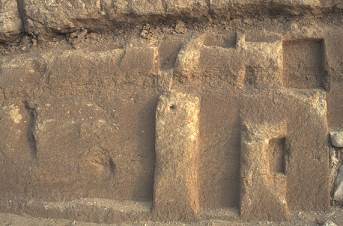
The left picture shows a block of about 3 m length which is prepared for breaking loose on 2 sides. This block would have been good for 2 - 3 Khufu-blocks. The picture on the right is interesting, too. It shows the boundary between the soft upper material (the one the Egyptians really quarried, according to Davidovits, and the hard limestone beneath. The one the Egyptians ignored because they had no tools to work it...
Another often heard question: Was there enough room in the quarries for all the needed workers? Well, the quarry in the southern region alone (one of 4 quarries used) had the dimensions 400 by 200 meters. If 420 stones were needed each day, and each working group could extract 2 blocks per day, 210 groups were needed on the 600 meter long front of the quarry. But there are suggestions that the 20 m thick lime stone layer was used in several steps, with only 3 steps in the quarry each group would have about 10 meters of working space. Although tere were 3 more quarries in use, this one alone would have had enough room for all teh workers. BTW: Accidentally we have calculated the number of basically needed quarry workers, too: about 1300 :-)
Davoidovits' method is much more complicated. For each stone about 3 tons of stone had to have been pulverized. Thin layer photos of the pyramid blocks showed no trace of compound stone, so it had to have been pulverized right down to the basic compounds - calcite cristals and micro fossils (see Steine und Steinbrüche im alten Ägypten, Springer 1991), to re-create the same material some 100 meters farer away. To get the same substance which could have been broken directly in the quarry. Absurd, in my eyes.
To pulverize enough material for one block a working team would have used much more time than to break loose one block. Example: To get one stone a trench of about 20 cm width, 1 m depth and 2.5 m length had to be hewn from the rock - about 0.5 cubic meters. Or 1 cubic metes for two stones a day. This material is not pulverized but only loosened with a pick. To produce a Davidovits-stone, you would need about twice the material loosened from a work team, but pulverised. That's at least about 4 times the work force - no, 8 times, because in the time you prepare ONE stone the Davidovits way, TWO are conventionally broken.
But thats not all. There are materials needed which are rare in Egypt. Gypsum in large amounts, which hat to be transported from the western desert. In large caravans. The gypsum had to be quarried there, too. And unslaked lime. Which gives another problem: the Egyptians had only one way to produce this, by putting glowing charcoal to broken lime stone. Therefore their unslaked lime was not the white powder we know, but a deep gray mixture. We can see the colour from the mortar they used on the pyramids, see for example Tab.(6). The char coal relics in the mortar were target of the radiocarbon dating project, too. So we would expect the pyramid stones to be of similar color - but they have exactly the colours of the local limestone at each pyramid site. The only explanation: They had a better method which they only used for lime in the geopolymer, but that would be silly, too. Why use a worse method in the mortar? It makes no sense.
Davidovits also has no explanation for the use of small blocks. Such casting methods have the great benefit that large structures can be produced in a single instant. You are not restricted to small blocks you could carry with a sled. Davidovits' answer in the Nova-production "This old Pyramid": "We only see the outside of the pyramids. Maybe larger structures were cast on the inside, we just don't see them."
Well, thats pure speculation and no evidence. And wrong again. Wen can see the inside on several places, like the large breach in Menkaure's pyramid and in several grave digger tunnels. All these are going without exception through small, individual blocks...
Davidovits also had a funny explanation for one main point of critique. Many stones are showing sedimantary layers, exacly the same as in the quarries. Well, thats's only coincidence, he claims. The stones could not have been made in one day, so during the night sand could have been blown in which was covered by new material the next day, and therefore just looks like sedimentation.
Well, what heve we stupid geologists, which cannot distinguish between flight sand and sedimentation. BTW: If not even a SINGLE stone could have been produced with Davidovits' methods in one day, how long should the pyramid have been built on?
The last piece of evidence is the Famina stela. This comes from the 3rd century BCE but should be a copy of a much older one. There you should find a recipe for artificial stone if you throw away the silly translations of the egyptologists:
"The translation introduces the elements discussed above
- "(Col. 11): There is a mountain massif in its eastern region (of Elephantine) containing all the ores, all the crushed (weathered) stones (aggregates suitable for agglomeration), all the products
- (Col. 12) sought for building the temples of the gods of the North and South, the stalls for sacred animals, the pyramid for the king, all statues that stand in temples and in sanctuaries. Moreover, all these chemical products are set before the face of Khnum and around him.
- (Col. 13)...there is in the midst of the river a place of relaxation for every man who processes the ores on its two sides.
- (Col. 15) Learn the names of the stony materials which are to be found...bekhen, dead (weathered) granite, mhtbt, r'qs, uteshi-hedsh (onion stone),... prdny, teshy.
(Col. 16) Learn the names of the rare ores located upstream...gold, silver, copper, iron, lapis-lazuli, turquoise, thnt (chrysocolla), jasper, Ka-y (radish stone), menu, esmerald, temikr (garlic stone), more over, neshemet, ta- mehy, hemaget, ibehet, bekes-ankh, green make up, black antimony, red ochre...
- (Col.18).. .I found the god standing.. .he spoke to me: "I am Khnum, your creator, My arms are around you, to steady your body, to
- (Col. 19) safeguard your limbs. I bestow on you rare ores upon rare ores... since creation nobody ever processed them (to make stone) for building the temples of the gods or rebuilding the ruined temples..."
The Famine Stele describes the invention of building with stone attributed to Zoser and Imhotep, builders of the first pyramid, the Step Pyramid at Saqqara (2,750 BC). According to the text, this invention of building with stone occurs through processing different minerals and ores which could be chemicals involved in the fabrication of man-made stone, or a type of concrete."
Well, this is no new translation, but only a summary of the texts which are really writen there. His method works like Sitchins Birch-workout: Use only what you need and summarize it as there would be a context between the far away standing sentences. In the original text I only could find lists of sacrifices for the god Chnum, and lists of materials which are produced in this part of Egypt. There are no "orders how to produce" something, the structure of the text itself is of another kind. I scanned the translation of the Famina-Stela from the original Roeder script "Urkunden zur Religion des Alten Ägypten, Übersetzt und eingeleitet von Günther Roeder, Jena, 1923"